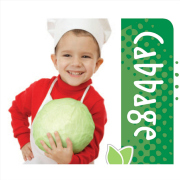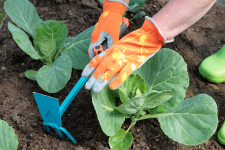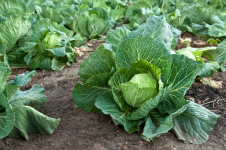Cabbage was first grown over 4000 years ago and now includes lots of varieties. ‘Space Saver’ is a great cabbage to grow in the backyard because it produces smaller cabbages and can be grown almost all year round. The large round cabbage in the centre is called the ‘head’ and will grow to just over 1kg in size. It might even be bigger than your own head!
Large, dark green leaves surround the head as it grows and these help to provide it with shelter from the sun. If the weather is really hot, these leaves can be loosely tied over the head to provide a little extra shade.
PLANTING
Choose a spot in the garden where there is lots of space and that gets at least 6 hours of sun every day. Prepare the garden bed by removing any weeds and digging in lots of compost and organic matter as cabbages like to grow fast! Adding a little extra granular fertiliser will help also.
Use a dibbler or big stick to make small holes about 40cm apart and gently place one seedling into each one, pushing the soil around the roots. Water the seedlings lightly.
‘Space Saver’ cabbage can be grown in very large containers such as barrels or tubs but there just needs to be enough room for them when they are larger. Fill the containers with premium potting mix and water it lightly. Make sure the container gets plenty of direct sunlight.
CARE AND MAINTENANCE
Cabbages need lots of food so that they can grow firm, crispy heads really quickly so give them a side dressing of granular fertiliser or water them with liquid fertiliser every fortnight. They also need lots of water so they may need daily handwatering, especially in summer.
Aphids and caterpillars like cabbages just as much as we do so it’s important to keep an eye out for them. If you see white butterflies around the veggie garden, these are ‘cabbage white butterfly’ and their caterpillars feed on the underside of the larger leaves leaving holes. Find out what to do about caterpillars.
HARVESTING
“Space Saver” cabbage is usually ready to be harvested about 60 days after planting and can be cut at any size but the head should feel firm. To harvest the cabbage, use a long knife to cut the stem under the head. The remaining large leaves, stem and roots can be thrown to the chooks or torn up and placed into the compost.
HOW TO EAT
A large head of cabbage can be a bit tricky to handle so ask mum and dad to cut it into quarters. These can be stored in plastic bags in the fridge until they are needed for dinner.
Cabbage is such a versatile vegetable because it can be eaten raw or cooked. Coleslaw is one of the most popular salads to take to a barbecue and is really easy to make. It can even be given an Asian flavour.
To serve cabbage really simply as a vegetable, shred it really finely and microwave or steam it for 3 or 4 minutes, stirring it half way through. Try not to overcook it as it is much nicer if it is still a little crisp. Just before serving, add a dob of butter and a little salt and pepper. Delicious!
Cabbage can also be shredded and wilted in a frypan with a little bit of olive oil. This only takes a few minutes. Try adding some chopped onion and bacon to the pan before the cabbage.
There are lots of recipes for cabbage in the Smarty Plants Kitchen.
HOW THEY GROW
Cabbage seedlings grow large, thick green leaves. The outer leaves are quite open and surround a ball of tightly woven leaves which forms the cabbage that we harvest to eat.
FAST FACTS
Botanical Name: Brassica oleracea capitata
Life Cycle: Annual
When to Grow: All year round
Height/Width: 40cm x 40cm.
Requirements: Plant in full sun and water them every day. Fertilise them at least every fortnight and make sure there is lots of compost in the soil.
Nutritional Benefits: Cabbage is a great source of vitamin C as well as folate and potassium. It’s also full of dietary fibre.



